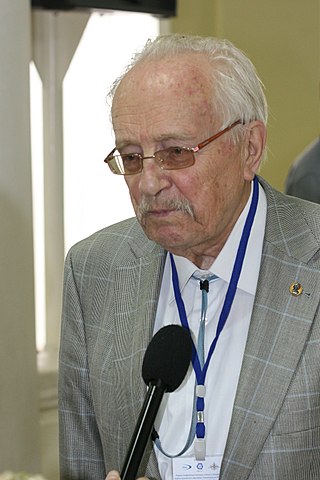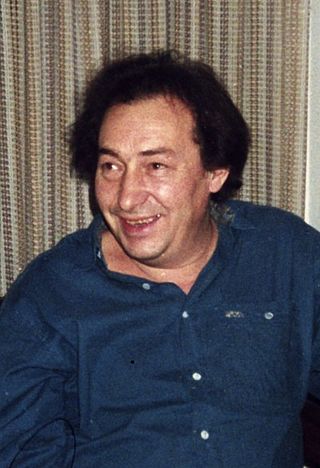Related Research Articles

Condensed matter physics is the field of physics that deals with the macroscopic and microscopic physical properties of matter, especially the solid and liquid phases, that arise from electromagnetic forces between atoms and electrons. More generally, the subject deals with condensed phases of matter: systems of many constituents with strong interactions among them. More exotic condensed phases include the superconducting phase exhibited by certain materials at extremely low cryogenic temperatures, the ferromagnetic and antiferromagnetic phases of spins on crystal lattices of atoms, the Bose–Einstein condensates found in ultracold atomic systems, and liquid crystals. Condensed matter physicists seek to understand the behavior of these phases by experiments to measure various material properties, and by applying the physical laws of quantum mechanics, electromagnetism, statistical mechanics, and other physics theories to develop mathematical models and predict the properties of extremely large groups of atoms.

The photoelectric effect is the emission of electrons from a material caused by electromagnetic radiation such as ultraviolet light. Electrons emitted in this manner are called photoelectrons. The phenomenon is studied in condensed matter physics, solid state, and quantum chemistry to draw inferences about the properties of atoms, molecules and solids. The effect has found use in electronic devices specialized for light detection and precisely timed electron emission.
Solid-state physics is the study of rigid matter, or solids, through methods such as solid-state chemistry, quantum mechanics, crystallography, electromagnetism, and metallurgy. It is the largest branch of condensed matter physics. Solid-state physics studies how the large-scale properties of solid materials result from their atomic-scale properties. Thus, solid-state physics forms a theoretical basis of materials science. Along with solid-state chemistry, it also has direct applications in the technology of transistors and semiconductors.
Quantum optics is a branch of atomic, molecular, and optical physics and quantum chemistry dealing with how individual quanta of light, known as photons, interact with atoms and molecules. It includes the study of the particle-like properties of photons. Photons have been used to test many of the counter-intuitive predictions of quantum mechanics, such as entanglement and teleportation, and are a useful resource for quantum information processing.
In condensed matter physics, a quasiparticle is a concept used to describe a collective behavior of a group of particles that can be treated as if they were a single particle. Formally, quasiparticles and collective excitations are closely related phenomena that arise when a microscopically complicated system such as a solid behaves as if it contained different weakly interacting particles in vacuum.

Yakov Il'ich Frenkel was a Soviet physicist renowned for his works in the field of condensed-matter physics. He is also known as Jacov Frenkel, frequently using the name J. Frenkel in publications in English.
A two-dimensional electron gas (2DEG) is a scientific model in solid-state physics. It is an electron gas that is free to move in two dimensions, but tightly confined in the third. This tight confinement leads to quantized energy levels for motion in the third direction, which can then be ignored for most problems. Thus the electrons appear to be a 2D sheet embedded in a 3D world. The analogous construct of holes is called a two-dimensional hole gas (2DHG), and such systems have many useful and interesting properties.
The Max Planck Institute for Solid State Research was founded in 1969 and is one of the 82 Max Planck Institutes of the Max Planck Society. It is located on a campus in Stuttgart, together with the Max Planck Institute for Intelligent Systems.

Alexander Leonidovich Kuzemsky is a Russian theoretical physicist.
The history of quantum mechanics is a fundamental part of the history of modern physics. The major chapters of this history begin with the emergence of quantum ideas to explain individual phenomena—blackbody radiation, the photoelectric effect, solar emission spectra—an era called the Old or Older quantum theories. Building on the technology developed in classical mechanics, the invention of wave mechanics by Erwin Schrödinger and expansion by many others triggers the "modern" era beginning around 1925. Paul Dirac's relativistic quantum theory work lead him to explore quantum theories of radiation, culminating in quantum electrodynamics, the first quantum field theory. The history of quantum mechanics continues in the history of quantum field theory. The history of quantum chemistry, theoretical basis of chemical structure, reactivity, and bonding, interlaces with the events discussed in this article.
Lev Petrovich Bulat was a Russian physicist.

Dmitry Vasil'evich Shirkov was a Russian theoretical physicist, known for his contribution to quantum field theory and to the development of the renormalization group method.

The Institute of Physics (IOP) of the National Academy of Sciences of Ukraine founded in 1926 is the oldest research institution of physical science within the academy. Being on the path of both infrastructure development and research diversification for more than 80 years, the institute has eventually originated five more specialized research institutions.
Emmanuel I. Rashba is a Soviet-American theoretical physicist of Jewish origin who worked in Ukraine, Russia and in the United States. Rashba is known for his contributions to different areas of condensed matter physics and spintronics, especially the Rashba effect in spin physics, and also for the prediction of electric dipole spin resonance (EDSR), that was widely investigated and became a regular tool for operating electron spins in nanostructures, phase transitions in spin-orbit coupled systems driven by change of the Fermi surface topology, Giant oscillator strength of impurity excitons, and coexistence of free and self-trapped excitons. The principal subject of spintronics is all-electric operation of electron spins, and EDSR was the first phenomenon predicted and experimentally observed in this field.

Arkady Girshevich Aronov was a Russian and Israeli theoretical condensed matter physicist, notable for his achievements in physics of semiconductors and in mesoscopic physics.
Kirill Borisovich Tolpygo was a Soviet physicist and a corresponding member of the National Academy of Sciences of Ukraine. He was recognized for his works on condensed matter theory; the theory of phonon spectra in crystals; electronic structure and defects in insulators and semiconductors; and biophysics. He created the Department of Theoretical Physics and the Department of Biophysics at Donetsk National University. Tolpygo was a teacher, mentor and scientific adviser to graduate students. Tolpygo was awarded the Order of the Great Patriotic War.
The Institute of Solid State Physics of the Russian Academy of Sciences is a research institution, located in the small town of Chernogolovka near Moscow in Russia. Founded on February 15, 1963, the institute has grown to become one of the largest physics institutes in the country. Its main fields of research are condensed matter physics and materials science.
Vsevolod Feliksovich Gantmakher, was a prominent Russian experimental physicist of Jewish origin, was born in Moscow as son of Felix Gantmacher, a prominent mathematician. He was a full Member of the Russian Academy of Sciences and is known for his fundamental contributions to condensed matter physics especially for the Gantmakher effect and Gantmakher–Kaner oscillations.
Gregory Evgenievich (Ezekielevich) Pikus was a Soviet theoretical physicist whose contributions strongly influenced developing physics of semiconductors. Among his most fundamental contributions are development of the method of invariants in band theory of solids, the Bir-Aronov-Pikus mechanism of spin relaxation of electrons, prediction of the circular photogalvanic effect, and theory of weak localization in noncentrosymmetric structures. His three monographs reflect the focus points of the theory of semiconductors during the second half of the 20th century from transistors to band theory to properties to artificial nanostructures.
Biswa Ranjan Nag was an Indian physicist and the Sisir Kumar Mitra chair professor at Rajabazar Science College, University of Calcutta. Known for his research in semiconductor physics, Nag was an elected fellow of the Indian National Science Academy and Indian Academy of Sciences. The Council of Scientific and Industrial Research, the apex agency of the Government of India for scientific research, awarded him the Shanti Swarup Bhatnagar Prize for Science and Technology, one of the highest Indian science awards for his contributions to Physical Sciences in 1974.
References
- ↑ Опубликован официальный некролог в связи с кончиной Бахрама Аскерова (in Russian) Archived 2015-01-10 at the Wayback Machine
- ↑ Бахрам Мехрали оглу Аскеров (in Russian). Archived from the original on 2015-01-10. Retrieved 2015-01-10.